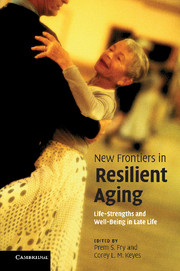Book contents
- Frontmatter
- Contents
- Figures
- Notes on contributors
- Foreword
- Acknowledgments
- Introduction
- 1 Sources of human life-strengths, resilience, and health
- 2 Growth is not just for the young: growth narratives, eudaimonic resilience, and the aging self
- 3 Physical resilience and aging:
- 4 You can teach an old dog new tricks:
- 5 Resilience in the face of cognitive aging:
- 6 Why do some people thrive while others succumb to disease and stagnation?
- 7 Psychosocial resources as predictors of resilience and healthy longevity of older widows
- 8 Resilience and longevity:
- 9 The socioemotional basis of resilience in later life
- 10 Emotional resilience and beyond:
- 11 Risk, resilience, and life-course fit:
- 12 Resilience in mobility in the context of chronic disease and aging:
- 13 Positive aging:
- Index
- References
1 - Sources of human life-strengths, resilience, and health
Published online by Cambridge University Press: 06 December 2010
- Frontmatter
- Contents
- Figures
- Notes on contributors
- Foreword
- Acknowledgments
- Introduction
- 1 Sources of human life-strengths, resilience, and health
- 2 Growth is not just for the young: growth narratives, eudaimonic resilience, and the aging self
- 3 Physical resilience and aging:
- 4 You can teach an old dog new tricks:
- 5 Resilience in the face of cognitive aging:
- 6 Why do some people thrive while others succumb to disease and stagnation?
- 7 Psychosocial resources as predictors of resilience and healthy longevity of older widows
- 8 Resilience and longevity:
- 9 The socioemotional basis of resilience in later life
- 10 Emotional resilience and beyond:
- 11 Risk, resilience, and life-course fit:
- 12 Resilience in mobility in the context of chronic disease and aging:
- 13 Positive aging:
- Index
- References
Summary
Abstract
The recent gerontological literature confirms that life-strengths are critical to the development of older adults' identity. Based on a review of the literature on aging, we present a conceptual framework and discourse on individuals' perceptions of their most valued sources of life-strengths from the psychological perspectives of existential-humanistic theory and social-cognitive theory. Viewed from an existential-humanistic perspective, individuals' major sources of life-strengths are rooted in individuals' definitions of personal meaning and purpose for life, in their religious faith and spiritual values and beliefs. From the perspective of social-cognitive theory, individuals' major sources of life-strengths derive largely from their self-efficacy and control beliefs. We examine elements that bridge across these two perspectives and we identify sets of psychosocial resources that are seen to facilitate resilience from both perspectives, and are also valued within a broad historical-cultural framework. We conclude that some individuals function more optimally than others because they have more successfully identified their most valued sources of life-strengths and psychosocial resources consistent with their belief system.
Introduction
What do we know about the sources of life-strengths that contribute to resilient aging and well-being of older adults? The answer is surprisingly little, compared with what we know about mental illness, dysfunction, and disorder in later adulthood. To date, the topic of human strengths and their determinants has been understudied. A lot is known about the genesis of depression, interpersonal stress, cognitive impairment, and physical decline in late-life functioning.
- Type
- Chapter
- Information
- New Frontiers in Resilient AgingLife-Strengths and Well-Being in Late Life, pp. 15 - 59Publisher: Cambridge University PressPrint publication year: 2010
References
- 22
- Cited by



